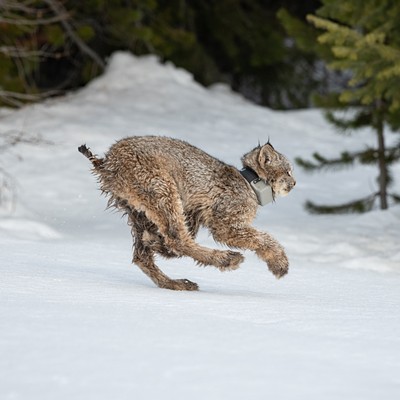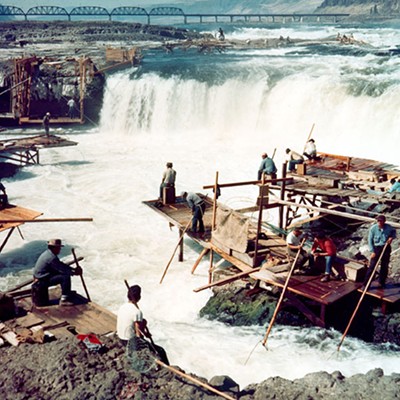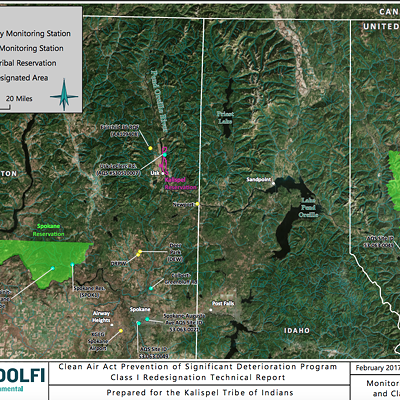The one place you can reliably go to hear Salish spoken is a funeral. Old aunties and grandmothers gather to talk of the dead and sing over their bodies. So it was last Saturday during a ceremony for Sue Finley, a matriarch of the Kalispel Tribe. Family and friends came from as far away as Montana to place a headstone on Finley’s grave in a little cemetery overlooking the Pend Oreille River and the mountains beyond. Afterward, Finley’s family gave away her possessions and hosted a feast in her honor.
Tribal members Francis Cullooyah and JR Bluff brought out the big hide drum and launched into an honor song for Finley in Salish, or “the language,” as they call it. A few others joined in.
There is a certain irony that Salish is often relegated to funeral services — because the language itself is in danger of dying. It’s more than just the language, though: Salish connects the Kalispel to their culture and their identity.
Finley, who died in March 2008, was among the dwindling number of elders who spoke qlispe (“kully-speh”) as a first language, and she was a strong advocate for adopting modern teaching methods to keep it alive. Thanks to video and audio recording — and a sense of urgency — a tribal language program that filled her final years is keeping Finley’s voice alive on computer disc.
But the language is still in jeopardy. “There are only four or five elders left who can talk it,” JR says. “We ask that the elders keep talking to us, we need to hear it. And if we don’t speak so well at first, have patience with us.”
Vicky Bowman, who is now studying the language, adds, “When I do speak the language, I feel like a part of my culture, like I belong to a people — to my people.”
A Few Words in Kalispel
| One | Nko’o |
| Two | Usel |
| Three | Tseles |
| Four | Mos |
| Five | Tsil |
| Man | Skaltumiax |
| Woman | Simmu’em |
| Sun | Spukani |
| Moon | Saka’am |
| Water | Se’uliq |
| Good morning | X.est-skwekwst |
| Thank you | Lem-lmtsh |
‘This Is Grim’
All around the interior Northwest, elders like Finley, who grew up speaking Salish in the home, are dying. Bowman says her mother, Louise, is probably the eldest fluent speaker now, a member of a small group that includes Cullooyah and JR’s dad, Stan Bluff.
Among the Coeur d’Alene, there are said to be two fluent speakers. Felix Aripa, the most visible of these, is tireless in his outreach, but he is 86.
Six fluent speakers are said to remain among the Spokane. The youngest of these is 72.
There may soon be an obituary that reads: “The language of the Schitsu’umsh [the Coeur d’Alene] died today in a field of camas bulbs. … It was 10,000 years old.” Or one that says, “The final words of the Spukani were last seen standup riding on the ghost of a giant chinook salmon as it jumped into the mists of the pounding Spokane Falls, formerly the center of the universe.…”
Even tribes that have a large number of fluent speakers are being hard hit.
“The Okanagan Nation in Canada lost 13 speakers,” says Chris Parkin, a former Spokane high school Spanish teacher who has been working on efforts to preserve Salish dialects.
“Thirteen in the last year?” someone asks.
“This winter,” Parkin says. “And they lost another semi-fluent speaker Saturday [May16]. That’s about 8 percent of the speakers. This is grim.”
The ‘Indian’ Thing
Like many Indians of his generation, JR Bluff, 44, speaks English as his first language and left the reservation — not by force to boarding schools or federal relocation schemes, but for college and a career.
He graduated 20 years ago from the University of Montana with a degree in forestry and worked 12 years as a forester for the Spokane Tribe. He later worked for the Kalispel tribal fish hatchery. JR, a high school athlete and outdoorsy guy, also began coaching basketball for Wellpinit High School and later at his alma mater, Cusick. In 2005, his team won the school’s first girls’ State B basketball championship.
He is still trim and compactly muscled, with big, fluid hands from a life spent working outdoors. He says hearing Salish spoken at funerals eventually led him on a path to exploring what it means to be a Kalispel Indian.
“Our situation with this tribe is we were pretty much in the white man’s world. We didn’t have our own people,” he says.
JR recounts that after the Sandpoint Treaty of 1887, the small group of Kalispel from the Usk area simply stayed right where they were. Most other Indians from Kalispel, Kootenai, Pend Oreille, Coeur d’Alene and Spokane were shifted off to the Flathead Reservation or to Plummer or Wellpinit.
The valley that runs up from Newport to Ione and Metaline Falls was off the beaten path, didn’t have much to offer settlers and remains sparsely populated by Indians and whites to this day.
“It wasn’t until the early 1900s that somebody said, ‘Hey! There’s still Indians over at Usk,’” JR says with a laugh.
The Kalispel didn’t get their 4,600-acre reservation until the 1930s, and even a generation ago, in the mid-1960s, the rez had one telephone and the average annual income was $1,400.
JR, afer years away from home, discovered his own identity at funerals. “That was Indian stuff. That was the Indian thing,” he says. He throws a fist into a palm to show how it suddenly hit him: “The hymns — boom! — it made you feel the connection that there was another world. There’s the sweat lodge, there’s the powwow, there’s the drum. Now I’m ready for it,” he says.
In the mysterious way of things, JR was tapped by elder Francis Cullooyah to be his assistant in the tribe’s culture office. Cullooyah has been a lion in preserving elements of Kalispel culture, and was first to start teaching the language.
Cullooyah says his grandfather, Joe Blackbear, foresaw the disappearing culture.
“I was about 11 or 12 when he told me one time, ‘You are going to be all alone one day. You are going to be the only speaker left. And it almost came true,’” Cullooyah says.
“Francis was it,” JR says. “People don’t think we dance, but we do. All of a sudden we started a drum group and we drum — we never drummed from here. Francis was the dancer, and now his kids dance and now I dance. It was always here. And now we are going to incorporate language into all that stuff.”
Race Against Time
All the regional tribes teach Salish and have been for decades on some reservations.
But here’s the thing, Chris Parkin says: When the Interior Salish-speaking tribes gather — as they did at last month’s Celebrating Salish conference at Spokane Falls Community College — they don’t ask, “How many new speakers do you have this year?” Parkin says. “That’s not the standard. What everybody talks about when they get together is: ‘How many did you lose this year?’”
Parkin was busily teaching Spanish at Gonzaga Prep until one day, several years ago, his wife asked him a question.
Parkin’s wife, singer LaRae Wiley, was looking for a way to reconnect with her heritage as a member of the Lakes Band of the Colville Confederated Tribes. She was teaching in the Head Start program on the Spokane Reservation and began taking Salish lessons.
Her progress seemed far slower than Parkin’s high schoolers at G-Prep. “His kids were speaking to him [in Spanish] after graduation, and I said, ‘Hey, how are you getting them to do that?’” Wiley says.
Well, I have all these resources, Parkin told her.
Parkin was later asked to master a CD of Spokane elder Pauline Flett singing and telling stories, and it was then that he began offering suggestions about different teaching methods and the need for a structured curriculum — suggestions not always well received.
“I am a rather blunt character, but let me just preface that I have nothing but the highest regard for the people who took LaRae in, and who took me in, and who gave us a place at the table,” he says. “But nobody had a plan.”
There are two significant factors that make learning Salish tougher than learning Spanish or French. One had to do with the approach of having elders teach — each with their own approach — where lessons often resulted in a list of words, Parkin says.
The other was personal: Indians didn’t just lose their language; it was stripped from them. Often with violence and shame.
“I’ve met elders who have scars on their hands from being hit with rulers,” Wiley says. “Even now, when they speak they get that emotional jolt of fear. Because of boarding schools and other history, there is a lot of emotional stuff tangled up in this.”
Parkin adds, “The language calls up another time, which has some good and powerful things, but also is painful. There are good reasons why it’s not simple and straightforward.”
The language itself is in painful shape, he and Wiley say, with essentially a handful of speakers.
“It is on a fine edge because we are running out of time, basically,” Wiley says.
Parkin cites nascent language programs on some reservations, inefficient programs on others, and plenty of back-biting over who can teach it and how. Can whites teach it? Who can learn it? What’s the best way?
“This is a tough, tough business,” Parkin says. “Are you looking for a happy, feel-good Indian story? Because this isn’t. This is gut-wrenching. There are days I think we are going to fail.”
Wiley and Parkin soon hooked up with like-minded souls who are working to keep Salish alive at the Paul Creek Language Association in British Columbia. They have recently created a spin-off in the United States, the Center for Interior Salish, to create materials and lesson plans and train teachers.
The Kalispel, worried by the deaths of fluent speakers — from 25 or 30 two decades ago to four or five now – were looking for a fresh approach. Francis Cullooyah had taken up the language baton about 10 years ago. Three years ago, he handed reins to JR, who promptly sought out Parkin for lunch and a long talk.
The tribe has been busy ever since.
Closing the Gap
“I used to have a regular job,” JR says, laughing as he gets the coffee pot fired up in the tribal language center, an airy blue house up on a hill that used to be the daycare.
Now, the house has the feel of headquarters for a battle — which is not far from how the staff and volunteers see it.
Since mid-2006, JR has taken a crash-course in Salish, and as soon as he learns new lessons, he teaches them to others so they, in turn, can also be teachers.
One of his top students is Jessie Fountain, an amazing 21-year-old. Fountain grew up in Houston, where her parents had moved before she was born. For 11 years, she was a big-city girl who did Girl Scouts and soccer, just like any kid.
But then her family came to visit relatives on the rez, and Fountain decided to stay and live with her grandmother. She felt a hunger to connect with her roots.
“I didn’t expect I was never going to see my friends or my house again,” she laughs. “But here, I felt like I had family everywhere. I felt like I was home.”
JR spends an hour alone, organizing materials for the final phases of the six-step curriculum. Soon Fountain and Vicky Bowman arrive and prepare for language classes that they’ll be teaching across the river at the Cusick public schools.
The tribe, JR says, is building a stair-step curriculum that right now has Kalispel I and Stories I, which assume a 600-word vocabulary, and Kalispel II and Stories II, which double the vocabulary.
Even as he is teaching Kalispel I, JR is learning Kalsipel II and organizing the curriculum for Kalispel III. He also is organizing an Ambassador’s Program to give high school students an opportunity to keep speaking the language through performance. He’s also trying to fund a position for a language teacher in the Early Childhood Learning Center.
His tiny office is bursting with plans, schemes and hopes.
As he gets the coffee going, JR can look out at the broad Pend Oreille River sluicing past the powwow grounds and the tribe’s buffalo herd.
“Growing up, there was only about 12 houses here. Now there’s about 70,” he says.
People are coming back. Right up to his grandparents’ generation, people learned Kalispel as a first language.
LaRae Wiley’s father, Parkin says, is the generation where language was lost in her family. They care for a granddaughter who is learning Nselxcin as a first language in their home.
“That is the gap,” Parkin says. “Our granddaughter can sit in the lap of her great-grandfather and that is the gap we have to close. It gives us hope we can do it.”
Direct Acquisition
By mid-morning and through the afternoon, Bowman, Fountain and JR shuttle back and forth over the bridge to Cusick, just on the other side of the river from the rez. They teach Salish from kindergarten through high school, presenting students with a list of words for the day and using them in illustrated stories about coyote and buffalo. There are plenty of games that help the students drill.
Two evenings a week after school, Bowman and Fountain gather at a round table in the language house with other adults for three hours of Salish from JR.
They use pretty much the same materials and techniques they used on the school kids — drilling for pronunciation, guiding word use in sentences and stringing sentences into stories.
“This is direct acquisition, meaning we want you to walk out with X amount of language that you can take home to your parents and you have something to talk about tonight,” says Parkin, who helped design the curriculum.
Most tribal language studies are overly influenced by linguistics, he says, “which is the math of languages. It’s the last thing an 8-year-old needs. Linguistics does not create speakers.”
In addition to hiring the Center for Interior Salish, JR also reached out to Salish elder Johnny Arlee from the Flathead Reservation in Montana.
Arlee has the ends of his long braids wrapped in red fabric, and it’s a kick to see him and Parkin, the quintessential white guy, going over the language with a magnifying glass.
Arlee is invaluable, the others say, for his vast vocabulary and a smooth sense of how Salish can be refined into qlispe.
As a younger man, Arlee was on a path going nowhere good, he says, until he was hired out of the blue to be the Indian consultant for the film Jeremiah Johnson, starring Robert Redford.
The experience stoked an interest to deeply reconnect with his heritage. Soon he was leading classes on the Flathead rez, and his teaching methods sound almost godlike: “We would walk all over the reservation naming everything we saw in the language,” Arlee says.
Flirting With Salish
During a lesson two weeks ago, a visitor asked the Cusick High School students, “When you are away from school and just hanging out together, does anybody flirt in Salish?”
There were laughs. But one girl seemed struck by the idea. “We do know the words,” she says. “Kiss. I want.” She seemed struck not so much by the idea of flirting, but by the notion that the language could be fun and not merely homework.
James Hunter, on the faculty of the ESL program at Gonzaga University, picks up on this. Look at the languages that have been rescued from oblivion, he says: Hebrew, Welsh, Catalan, Maori. In every case, the language drenches the speaker with a unique membership in a select group that exists inside, but separate from, a dominant culture. It can even be subversively cool.
“A teacher should be saying, ‘When you walk around off the rez, nobody understands you when you speak Salish.’ There are ways to make this sound cool for kids,” Hunter says. “For kids, there has to be some obvious evidence that this is something that is valuable, that this is not just the language of my grandparents, but it is my identity.”
But what if most kids just want to party instead of learn the language?
“Have a fun party in Salish,” he says.
And just as people in Catalonia saved their language from being swallowed by the dominant Spanish language, “You have to see it in media,” Hunter says. Radio, TV, texting, Facebook.
“You just know somebody is out there ready to do that project, Facebook in Salish, where before nobody would even take that on.”
Who Will Sing?
Taking a break from adult Salish class back on the rez, Fountain sits outside on the tailgate of her pickup truck, talking. She has legs so long and thin that they lend her the appearance of a graceful wading bird. Her truck is perched on a hill near tribal headquarters where the sweeping view shows the Pend Oreille River rushing past, muscled with thick, ropy waves. The blue flower of camas in bloom shimmers against the verdant flood plain. Osprey hang in the sky. Snow atop Calispell Peak gleams like polished bone.
Her birdlike legs swing in anxious rhythm as she speaks.
“I am scared every day.”
Her legs kick out, pull back. Like pumping on a swing.
Sitting on the tailgate of a sporty pickup truck in the welcome sun that defeated the fuzzy gray clouds and cold rain, why scared?
“Every day that goes by, people get older.”
The steady kick, pump.
“Every day that goes by that I don’t learn something new, I get scared. Kids my age run and party. The language is not important to them,” Fountain says.
“Stan [JR’s father] put it to me very simple: The government can come here one day and ask ‘Do you know your language?’ If we don’t know our language and if we don’t know who we are, we are just like everyone else,” she says. “The rest of the suyape [white] world is about time and money and us as Native people, we just don’t think that way.”
The swinging of her legs is hypnotic. She is nearing the heart of what scares her. “As Indian people,” she says, “we do things a certain way so a person is prepared to travel well.”
At funerals, she says, the old people come and sing. They sing hymns in the language. Hymns that send a spirit on its way, peaceful and well prepared for the journey. The last songs sung for you are in the language that makes you qlispe.
When Fountain grows old, what if the elders have died and the children have continued partying, and there is no one left who speaks the language?
“I want to be buried like a respectful elder — that is important to me,” she says.
Her legs become still.
“The scary thing is: Who will bury me? Who will sing for me when I die?”




















